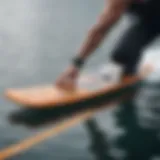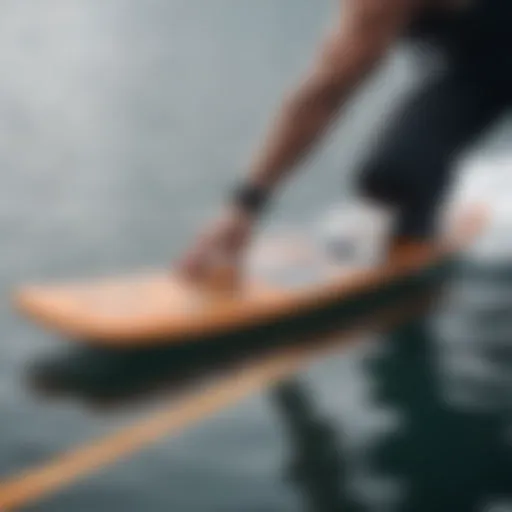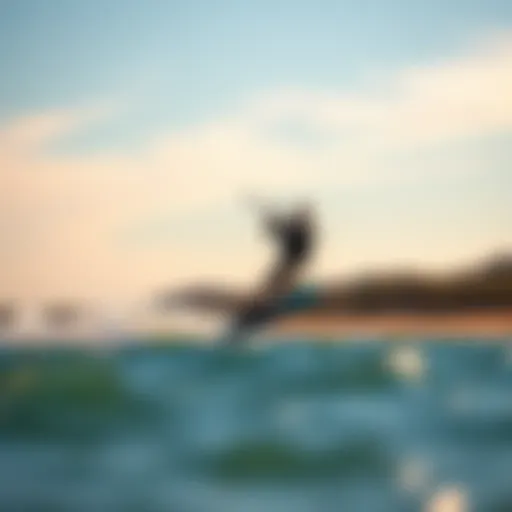Mastering Kiteboarding: An In-Depth Learning Guide


Intro
Learning kiteboarding is like stepping into a world that blends adrenaline with the beauty of nature. For those looking to conquer the waves harnessing the wind’s power, this sport offers both freedom and challenge. Whether you're a novice drawn to its allure or a seasoned rider seeking fresh techniques, diving into kiteboarding can be a thrilling, yet daunting venture.
This guide is designed to be your companion on this journey, covering essential aspects from choosing the right gear to mastering advanced maneuvers. By the end of this article, you’ll grasp the fundamentals and advanced nuances of kiteboarding, ensuring you're not just riding the wind, but truly understanding it.
Gear Insights
Understanding the right gear is the cornerstone of kiteboarding. The equipment you select not only influences your performance but also your safety and enjoyment.
Latest Gear Reviews
The world of kiteboarding gear is continually evolving. New technologies and designs emerge frequently, aiming to enhance your experience on the water. Let’s take a look at some standout products hitting the market recently:
- Naish Pivot Kite: Known for its predictable handling and versatility, this kite shines in various wind conditions, making it suitable for beginners and experienced riders alike.
- Duotone Trust Bar: A popular choice, the Trust Bar features a comfortable grip and intuitive release system, ensuring you have full control when out on the water.
- Mystic Dutchess Harness: With its comfortable fit and durable construction, this harness provides excellent support, allowing riders to focus on technique rather than discomfort.
Essential Gear for Beginners
If you’re just starting, the multitude of gear options can be overwhelming. Here’s a basic list of must-have equipment:
- Kite: Depending on your weight and the wind conditions, a kite ranging from 7 to 12 meters is generally a good starting point.
- Board: A twin-tip board is often recommended for beginners since it's versatile and allows you to ride in both directions.
- Harness: Comfort is key; a well-fitting harness will make your rides more enjoyable.
- Safety Gear: Don’t skimp on safety. A helmet and impact vest can make a significant difference in terms of protection.
"Investing in quality gear saves you pain and financial strain in the long term; cheap equipment can lead to costly injuries."
Familiarizing yourself with this gear will build your confidence. As you progress, you can explore more specialized items suited to your growing skills and preferences.
Techniques and Tips
With the right gear in hand, it’s time to tackle the techniques that will turn you into a proficient kiteboarder.
Advanced Tricks and Techniques
Once you’re comfortable with the basics, pushing yourself to learn new tricks can elevate your kiteboarding experience. Here are a few advanced maneuvers to set your sights on:
- Jumping: Timing and kite control are key components for executing jumps successfully. Start with small hops and gradually progress to higher flights.
- Backrolls: This trick involves a rotation during a jump. It’s crucial to spot your landing to maintain control upon descent.
- Kiteloops: This may look complex, but with practice opens up exciting possibilities in your riding style. Ensure you're comfortable in strong winds before attempting.
Safety Practices for Kiteboarders
Safety cannot be an afterthought. Incorporate these practices into your routine:
- Know the Weather: Always check the local wind conditions and forecasts before heading out. Wind can change rapidly, and being unprepared can lead to dangerous situations.
- Practice in Safe Zones: Start in designated kiteboarding areas, especially when you’re still mastering your skills. Other riders can also offer assistance and tips.
- Have an Emergency Plan: Know how to self-rescue and what to do in case of equipment failure.
By adhering to these strategies and continuously refining your techniques, you’ll progressively build a solid foundation in kiteboarding. Keep pushing your limits, but always prioritize safety and skill refinement.
As you embark on this enticing adventure, remember that kiteboarding is as much about community as it is about the thrill. Engaging with others in the kiteboarding world can provide insights, camaraderie, and a wealth of knowledge to enhance your experience.
Prologue to Kiteboarding
Kiteboarding, a sport that marries the thrill of surfing with the art of flying a kite, is more than just a recreational activity; it's a doorway into a world filled with adrenaline and connection to nature. Understanding the fundamentals of kiteboarding is the first step for anyone looking to master this exhilarating sport. Not only does it provide a unique way to interact with the elements, but kiteboarding also fosters a sense of community among enthusiasts from all walks of life.
This section lays the groundwork for newcomers and offers seasoned riders a chance to deepen their knowledge. Getting acquainted with kiteboarding's essence, including its various techniques and equipment, can enhance one’s enjoyment and ensure a safer experience on the water. With a focus on the sport's primary aspects, readers will be well-equipped to dive into the subsequent sections.
Understanding the Sport
Kiteboarding combines aspects of surfing, windsurfing, and paragliding, creating a multifaceted adventure. In essence, riders harness the wind by controlling a large, inflatable kite while riding on a board. This unique sport is not only physically challenging but also mentally engaging, requiring awareness of the environment, particularly wind conditions.
The significance of kiteboarding lies in its ability to connect individuals to nature's raw power. By mastering kite control and board techniques, riders experience not just the thrill of movement but also a profound appreciation for the ocean and the skies.
One of the first things to grasp is the wind window – the area in which the kite flies, and understanding this concept can make a world of difference, especially for beginners. Properly managing kite position allows for smooth rides and minimal risks.
History and Evolution
Kiteboarding has a rich history dating back to the late 1970s when its roots can be traced to the innovative minds seeking new forms of surfing. Originally, the sport used simple surfboards with kites designed for traction. However, it wasn't until the late 1990s that kiteboarding truly took off, with equipment advancing rapidly, allowing greater heights and longer distances.
The evolution continued with the introduction of different types of kites, such as C-kites, bow kites, and delta kites, each catering to various riding styles and conditions. Over the years, the sport has selectively blended techniques from windsurfing and surfing, refining safety measures and increasing accessibility for beginners.
From competitive events that showcase daring tricks to leisurely rides on serene waters, kiteboarding has grown into a multifaceted sport enjoyed worldwide. As it has developed, the kiteboarding community has flourished, leading to numerous clubs and organizations dedicated to promoting safe riding practices and inclusivity for every skill level.
Understanding the origin and growth of kiteboarding not only pays homage to its pioneers, but also fosters appreciation for its rich culture that thrives across beaches globally.
Essential Gear for Kiteboarding
When stepping into the world of kiteboarding, understanding the essential gear is critical. This equipment can greatly influence not only your performance but also your overall experience in this thrilling sport. Well-chosen gear enhances safety, boosts progression, and ensures that every session on the water is enjoyable.
Choosing the Right Kite
Selecting the proper kite blends various factors, including your skill level, riding style, and the wind conditions typical for your chosen locations. Kites come in different shapes and sizes, and their characteristics can greatly impact your flying experience.
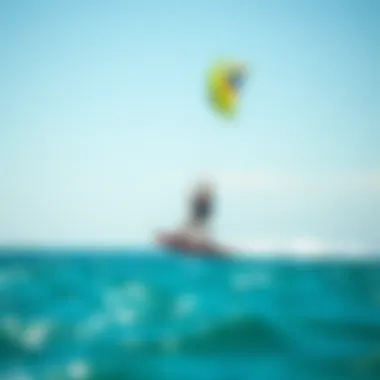
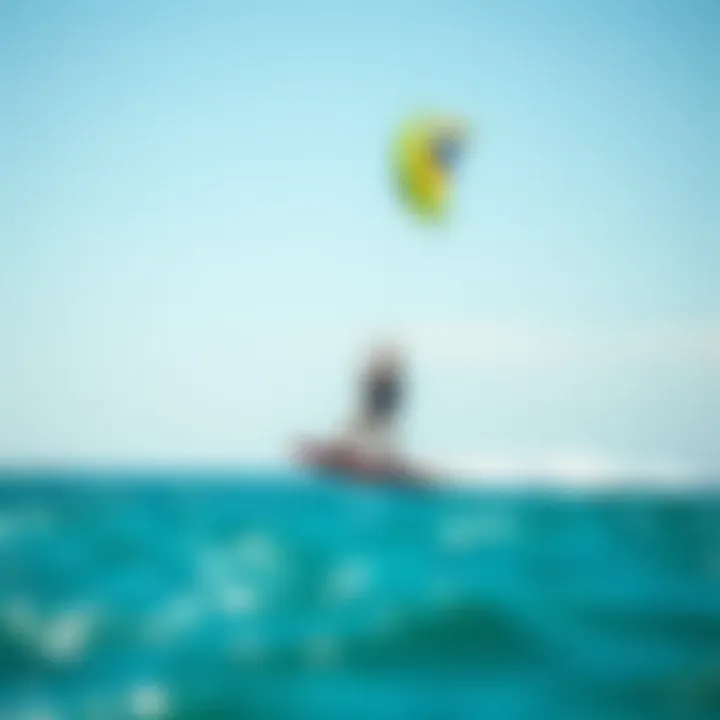
- Size Matters: Generally, larger kites are suitable for lighter winds, while smaller kites handle stronger winds better. A kite that is too big for the conditions can lead to loss of control, while one that is too small may not give enough power.
- Type of Kite: The two main types are C-kites, known for their responsiveness and power, and bow kites, which provide better depower and are easier to control, especially for beginners. If you're just starting out, a bow kite can make the learning curve a bit gentler.
- Inflation and Material: Inflatable kites are most common due to their versatility and ease of use. Look for durable materials that withstand wear and tear while ensuring seamless inflation and deflation.
Selecting a Board
Your board is as important as your kite, as it acts as your connection to the water. Choosing the right board can significantly impact your performance and comfort.
- Type of Board: Kiteboards come in many varieties such as twin tips, directional boards, and surfboards. A twin tip is typically best for beginners since it can be ridden in either direction, which helps in developing skills without the frustration of constantly changing direction.
- Size and Volume: The size and volume of the board affect how easy it is to get up on the water and how well it holds in different conditions. A larger board offers more buoyancy which is helpful when you’re just starting out, while a smaller board provides more maneuverability as your skills improve.
- Riding Style: If you’re aiming to jump, look for a board with a bit of rocker. This will give you the lift needed to get airborne. Conversely, a flatter board works well for speed and stability if you’re focused on cruising.
Safety Equipment and Accessories
Safety should always be the top priority in kiteboarding. Having the right safety equipment can mitigate risks and give you peace of mind while you're out on the water.
- Personal Flotation Devices (PFD): A well-fitted life jacket or buoyancy vest is fundamental. It keeps you afloat should you find yourself in trouble, providing an extra layer of security.
- Harness: A sturdy harness is essential for attaching yourself to the kite while allowing freedom of movement. Ensure it fits comfortably and provides adequate support without constraining your movement.
- Safety Leash: This is an important accessory that connects you to the kite. If you accidentally let go or become disconnected from your kite, the leash will prevent it from flying away uncontrollably.
- Helmet: Always don a helmet to protect against head injuries, especially when you’re learning or attempting new tricks. It’s a small price to pay for safety and can greatly reduce the risk of serious injury.
"Safety gear isn't just a suggestion; it's your ticket to riding smarter, not harder."
- Other Accessories: Take into account sun protection, like rash guards and sunscreen, as sessions can be long under the sun. Also, consider sunglasses or goggles to shield your eyes from water spray and UV rays.
Fundamental Skills for Beginners
Kiteboarding may seem daunting at first glance. However, laying a strong foundation in the fundamental skills is not just important—it's crucial for the safety and enjoyment of the sport. The initial stages of kiteboarding equip you with the tools necessary for navigating the wind and water effectively. Without these core skills, students may face challenges that could cultivate apprehension rather than excitement.
When you master fundamental techniques, you unlock the potential for progression. This progression ensures that you can develop higher-level skills confidently and safely. Thus, investing your time in the fundamentals is wise and rewarding.
Kite Control Basics
A kite is more than a piece of gear; it’s your connection to the wind. Mastery of kite control involves understanding how to manipulate the kite in various wind conditions. Key concepts include:
- Launching and Landing: Knowing how to launch your kite safely and land it without mishaps is paramount. Practice with an instructor until you feel comfortable.
- Steering Techniques: The way you steer the kite with the control bar affects your speed and direction. Practice moving the kite in all positions, recognizing how it reacts to changes in the wind.
- Power Zones: Understanding power zones—where the kite generates the most pull—can make or break your session. The kite produces the most power when positioned directly overhead and towards the edges of the wind window. Learning to navigate these zones will allow you to harness the wind effectively.
These skills set the stage for a safer and more enjoyable experience on the water. With practice, your kite control can turn from a mere necessity to an effortless second nature.
Understanding Wind Dynamics
Wind is the unifying factor in kiteboarding. Getting a grip on wind dynamics is not only essential—it's a game changer. Recognizing wind patterns will enhance your riding experience significantly. Consider the following aspects:
- Wind Speed: Learn to assess wind speed before heading out. A gentle breeze may be suitable for beginners, while high winds can lead to challenging conditions. Beginner-friendly wind speeds typically range from 12 to 20 knots, depending on experience.
- Directional Changes: Wind does not blow in a straight line. Learn to identify shifts, gusts, and lulls—these can alter how your kite behaves. Being adaptable in response to these changes keeps you in control.
- Local Conditions: Observe the geographical factors that influence wind patterns in your area. Are there trees nearby? Is there a beach that funnels wind? Such knowledge helps you choose the optimal spot to kiteboard safely.
Grasping wind dynamics helps you anticipate and react, minimizing surprises that could lead to mishaps.
Body Positioning and Balance
Your body acts as an anchor in kiteboarding, and how you position it can affect balance and control significantly. Key considerations include:
- Stance: Maintain a slightly bent knee stance to absorb shocks from the water, keeping your center of gravity low. This stance aids in stability and responsiveness.
- Weight Distribution: Shifting weight onto your back foot while riding allows for effective turns and acceleration. Practice finding that balance through drills that emphasize weight control.
- Upper Body Control: Keep your upper body relaxed but engaged. Tensing up can create unnecessary strain, and good upper body mobility allows for quick reactions to shifts in balance.
Practicing body positioning strengthens your overall skill set, promoting proficiency in handling the board under varying conditions.
Mastering these fundamental skills paves the way for a rewarding kiteboarding journey, ensuring safety and confidence on the water.
By developing kite control, understanding wind dynamics, and achieving proper body positioning, beginners can set the stage for lifelong enjoyment in kiteboarding. These foundational skills not only serve as building blocks but also instill confidence, allowing newcomers to approach the sport without fear and with enthusiasm. For additional resources related to these fundamentals, consider visiting sites like Wikipedia or engaging in community discussions on Reddit.
Progressing Your Skills
To truly harness the exhilaration of kiteboarding, progressing your skills is non-negotiable. This journey not only amplifies your confidence but also unlocks a new realm of possibilities on the water. As you become more adept, you’ll find that each trick and technique enhances your understanding of this dynamic sport. The emphasis here isn't just on mastery; it’s about creating a safer and more enjoyable experience.
Learning to Get Up on the Board
Getting up on the board may seem like a daunting task at first, but it lays the groundwork for all subsequent maneuvers. In this phase, your attention should be on your stance and the connection between your body, kite, and board.
- Get Comfy with the Kite: Mastery of kite control is essential. Focus on how the kite responds in different wind conditions while lying on your back in the water. The beauty of kiteboarding lies in this synergy; knowing how to navigate the kite will ease your transition up.
- Body Positioning Matters: Your starting position is key. A common mistake is leaning too far back, which can lead to an awkward face-plant. Keep your weight centered and your knees bent; try to maintain a low profile—think of yourself as a coiled spring ready to launch.
- The Launch Sequence: When you feel confident, pull yourself up while pulling on the handle. It’s akin to a synchronized dance—the kite needs to catch the wind just as you establish your balance on the board.
"A strong launch will set the tone for a great ride!"
Improving Your Riding Techniques
Once you can get up on the board, it’s time to refine your riding techniques. It’s essential to transition from simply staying on the board to truly mastering it.
- Focus on Edging: Begin experimenting with the edge of your board. This not only improves stability but also provides more control in your movements. Learning to edge gives you precision, which is vital as you begin to maneuver through different water conditions.
- Practicing Turns: Engaging in sharp turns can transform your riding. Start with gentle shallow turns and gradually progress to more intricate ones as comfort grows. Getting the hang of these turns while maintaining speed is critical.
- Kite Angles: Understanding kite angles is crucial for optimizing speed and jumps. The kite should consistently be positioned to catch the prevailing wind, allowing for smoother gliding.
Mastering Turns and Transitions
When it comes to kiteboarding, fluid transitions and turns make all the difference. They allow for a more comprehensive riding experience and can impress onlookers.
- Executing a Smooth Turn: The easiest way to begin is with short, simple turns. As you gain confidence, you should aim for sharper and faster turns. The key is to shift your weight in sync with the kite’s movements.
- Swapping Directions: Transitioning from toe-side to heel-side riding requires practice. Remember to keep your body low when switching stances. Pressuring the toes of your board will help you maintain your balance while you execute the move.
- Riding Switch: Learning to ride switch is a game changer. Not only does it enhance versatility, but it can also make your riding appear more fluid. It might feel awkward at first, but with persistent practice, you will find your rhythm.
By focusing on these aspects, kiteboarders can enhance their skills significantly. Progression in skills is a natural part of your kiteboarding journey and should not be rushed. Experience is your best teacher, so invest the time and embrace every fall as part of learning.
With each step forward, you will find yourself not just riding the waves but also owning them. Keep pushing yourself, stay safe, and most importantly, enjoy every moment out on the water.
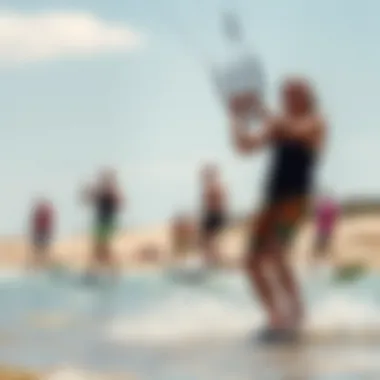
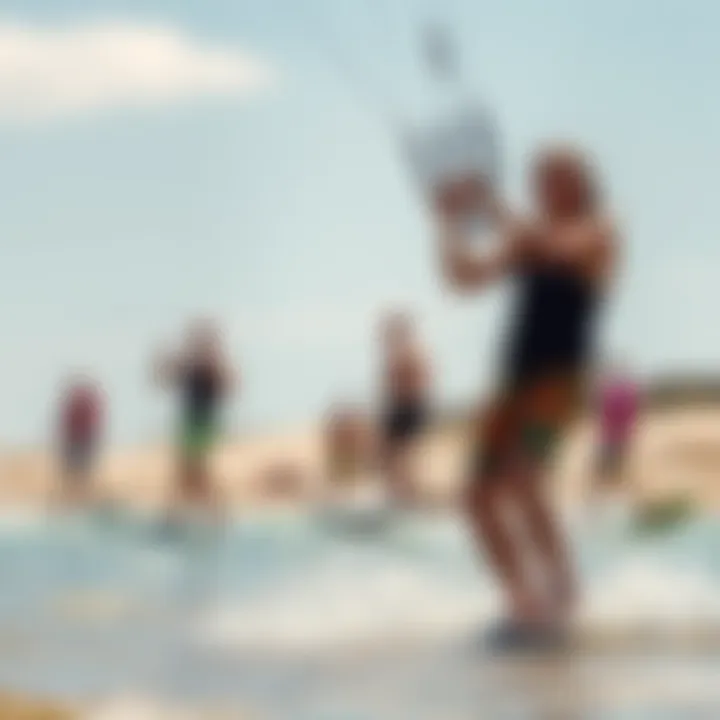
Safety Considerations in Kiteboarding
Safety is paramount when it comes to kiteboarding. As exhilarating as this sport can be, it also poses a range of risks and challenges that every rider should be aware of. Prioritizing safety not only protects individuals but also promotes a positive image of kiteboarding as a whole. Understanding the intricacies of safety measures can significantly reduce the likelihood of accidents and injuries, ensuring that everyone can enjoy the thrill of kiteboarding responsibly.
Understanding Local Conditions
Before embarking on your kiteboarding adventure, it’s essential to familiarize yourself with the local conditions. Each spot can present a unique set of challenges influenced by the geography, water quality, wind patterns, and even the presence of other water users – from waveriders to paddleboarders.
- Wind Patterns: Learn how winds change throughout the day. The reliability and strength of winds can vary significantly. For instance, morning winds might be smoother, while afternoon gusts can catch a novice off guard.
- Tides and Currents: Knowing how tides affect the water depth and current flow is crucial. Certain kiteboarding spots may become hazardous during low tides, exposing hidden obstacles. It's always a good idea to check tide charts to plan accordingly.
- Weather Conditions: Monitor weather changes closely. Sudden storms can lead to violent winds and unsafe conditions. Use weather apps or websites specializing in local forecasts – they give real-time updates that can save your skin.
Understanding these factors can set you up for a successful session or, conversely, save you from a potential mishap.
Practicing Safe Launching and Landing
The moment you launch or land your kite is when you are most vulnerable. These moments require heightened awareness and practiced technique. Here are some key practices:
- Designate Launch Zones: Always choose clear areas free of obstacles, both above and below the water. A crowded launch zone can lead to painful collisions.
- Communication: If you’re with a group, establish clear communication signals for launching and landing. A shout or a wave can indicate readiness and mitigate confusion.
- Check Equipment: Before launching, take a moment to inspect your gear. Snags in lines or worn-out equipment can lead to accidents. It’s always better to be safe than sorry.
Landing also requires skill and precision. Landing with control means you can avoid crashing into others and maintain control of your kite.
Emergency Procedures
No matter how prepared you are, emergencies can happen. Familiarizing yourself with emergency procedures is a fundamental aspect of kiteboarding safety.
- Know How to Self-Rescue: In cases where your kite lands in the water, knowing how to self-rescue is vital. Practice this skill, so it becomes second nature. When out in water, don’t panic; secure your kite and swim it to the beach with you.
- Have a Safety Plan: Always kite with a buddy or let someone on land know your plans. If things go south, having someone to help or alert authorities can make all the difference.
- Use Safety Gear: Equip yourself with a PFD (personal flotation device) and a kite leash. These can be crucial in emergencies and should not be overlooked.
"Preparation is key; knowing your local conditions and having a solid plan can make the difference between a good session and a bad day out on the water."
By integrating these safety considerations into your kiteboarding routine, you will not only enhance your own riding experience but also contribute positively to the sport's environment. Riding smart goes a long way in ensuring that kiteboarding remains a fun, rewarding, and safe activity for everyone.
Kiteboarding Communities and Resources
Kiteboarding, at its core, is not just a sport; it's a vibrant community that thrives on shared experiences, knowledge, and passion. This guide will delve into how connecting with fellow kiteboarders can significantly enhance your journey in mastering this exhilarating sport. From finding the right instructors to tapping into online forums, the resources available can elevate your skills and confidence on the water.
Finding Local Schools and Instructors
One of the first steps for any aspiring kiteboarder is to seek out local schools and qualified instructors. Taking lessons from seasoned professionals can fast-track your learning curve and ensure you are starting off on the right foot. These instructors not only teach you the basics but also instill essential safety practices, which is crucial for beginners.
Indeed, learning in a structured environment surrounded by experienced coaches can offer you a rich pool of resources and insights that might be hard to come by otherwise.
- Benefits of Local Schools:
- Personalized attention according to your skill level.
- Access to well-maintained equipment.
- Opportunities for group lessons and social interactions.
An example of such a school is the KiteSurf School in Maui, offering not only lessons but also organized outings to perfect your skills while enjoying stunning views. An instructor can analyze your form and technique on the spot, providing feedback that is immediate and applicable.
Don’t forget to check out websites like Kiteboarding Schools for reviews and recommendations that can guide your choice.
Joining Online Forums and Groups
In today’s digital age, connecting with like-minded enthusiasts through online forums and groups has become a staple for many kiteboarders. These platforms serve as a haven for sharing tips, advice, and insights that pertain to the sport.
Joining groups on platforms like Reddit or Facebook can help you tap into a collective wealth of knowledge. Here you can discuss gear recommendations, travel impressions, local conditions, and even find kiteboarding buddies to hit the water with.
- Key Benefits of Online Communities:
- Access to a wide range of discussions that can broaden your perspective.
- Real-time support for any questions you might have.
- Opportunities to participate in local meetups or events.
It's a global village where experiences from one part of the world can influence kiteboarding techniques or equipment choices in another. One thread might bring a unique insight about wind conditions in the Caribbean, while another could help you find the best kite schools near you. Remember, participation is key; the more you engage, the more you’ll benefit.
Building connections both offline and online can lead to invaluable friendships and opportunities, enhancing your overall kiteboarding experience.
In summary, finding local schools gives you the guided instruction that accelerates your learning. Simultaneously, online communities provide a broader support network to exchange ideas and tips that can transform your kiteboarding journey into a fulfilling adventure.
Travel Destinations for Kiteboarding
In kiteboarding, choosing the right destination is akin to selecting a perfect wave; it shapes your experience on the water. Not only does it enhance skill development, but it also immerses you in diverse cultures and breathtaking landscapes. Locations play a crucial role in the conditions you’ll encounter, which can affect everything from wind strength to the wave quality. By selecting a prime spot, you gain access to consistent winds, scenic beauty, and an opportunity to connect with other enthusiasts.
When planning a trip, it’s vital to consider the climate, wind patterns, and accessibility of your destination. Each region boasts unique features that can enhance your learning experience while also providing a sense of adventure beyond the sport.
A destination’s environment can inspire confidence, allowing kiteboarders to step out of their comfort zone while refining their skills.
Top Global Locations
Kiteboarding has blossomed across many corners of the globe, offering something for every level, from novice to pro. Here are some standout locations that should be on every kiteboarder’s radar:
- Tarifa, Spain: Often dubbed the "kiteboarding capital of Europe," Tarifa is famed for its strong winds and dynamic beach scene. The windy conditions here are reliable almost year-round, making it a hub for both learning and advanced riding.
- Hood River, USA: Nestled alongside the Columbia River, Hood River provides consistent winds and stunning scenery. Known for its vibrant kiteboarding community, it’s an ideal location for those looking to enhance their skills while soaking up the Pacific Northwest vibes.
- Cabarete, Dominican Republic: With beautiful beaches and warm waters, Cabarete attracts kiteboarders from all over. The thermal winds here ensure optimal conditions, especially in the afternoon. The local vibe is laid-back, with numerous schools available for instruction.
- Kite Beach, St. Lucia: St. Lucia serves up a blend of lush landscapes and steady winds perfect for kiteboarding. For those seeking a picturesque getaway with their sport, Kite Beach offers attractive conditions along with stunning backdrops.
- Maui, Hawaii: Though perhaps better known for its surfing, Maui has superb kiteboarding conditions in places like Kanaha Beach. The island’s variety of wind strengths caters to both beginners and seasoned riders.
Planning Your Kiteboarding Trip
Planning a kiteboarding trip requires a bit of foresight and organization, given the myriad of factors that can influence your experience. Here are key points to consider when laying out your plans:
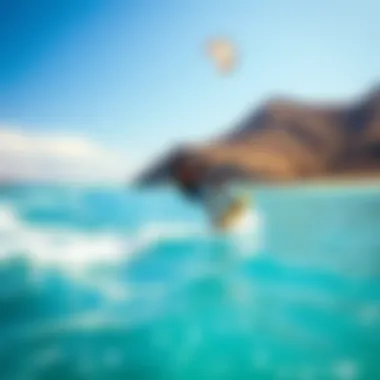
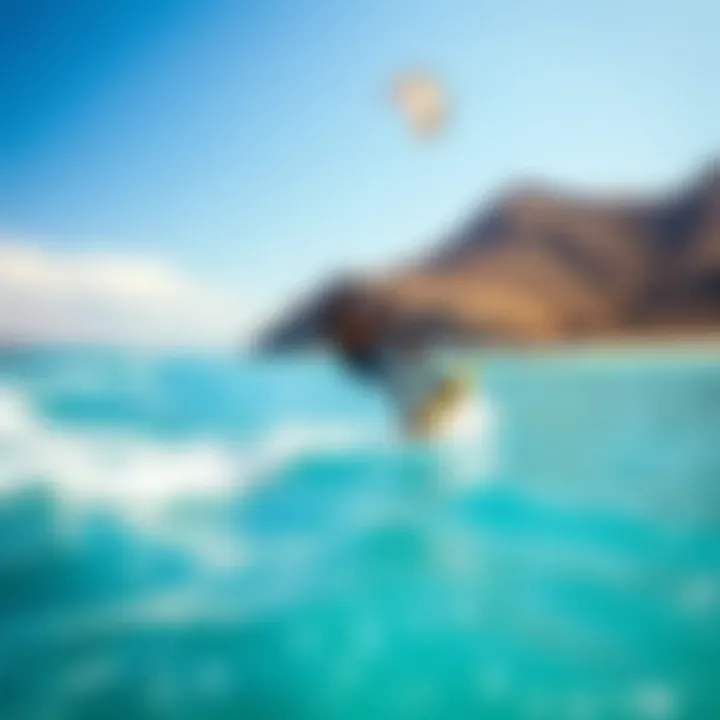
- Research Weather Conditions: Familiarize yourself with the best seasons for kiteboarding in your chosen destination. Wind patterns can vary greatly, impacting your opportunities on the water.
- Book Accommodations Wisely: Look for lodgings near the beach or kiteboarding schools. Proximity to the water not only cuts down on travel time but often improves access to local amenities.
- Invest in a Reliable Kite School: If you’re new to the sport, finding a school with good instructors is essential. Reading reviews or seeking recommendations often leads to a more enriching learning experience.
- Pack Essentials: Don’t skimp on gear. A checklist can help ensure you have your kite, harness, board, and safety equipment ready. Additionally, remember sunscreen and appropriate clothing to protect against the elements.
- Connect with the Local Community: Many destinations have vibrant kiteboarding communities. Engaging with local riders can provide professional tips based on regional conditions, enhancing your overall experience.
- Be Open to Last Minute Changes: Weather can be unpredictable. Stay flexible and keep an open mind to adjust your plans as needed for the best kiteboarding conditions.
By evaluating these aspects, you can significantly enhance your trip, ensuring your kiteboarding adventure is filled with learning and the thrill of the wind beneath your kite.
Advanced Techniques and Tricks
Advancing in kiteboarding is a thrilling journey that goes beyond just the basics. The realm of advanced techniques and tricks opens up a new dimension of excitement and self-expression on the water. Mastering these skills not only enhances your confidence but also elevates your overall kiteboarding experience. Incorporating new maneuvers can improve your agility, increase your speed, and allow for more dynamic interactions with the wind and waves.
For many, this stage of kiteboarding is where personal flair shines. Learning advanced tricks often involves a blend of athleticism, creativity, and an intuitive understanding of your equipment. However, it’s essential to approach this phase with preparation and caution. The complexity of these techniques requires a thorough grasp of basic skills. One should ensure that they have a solid foundation before attempting more challenging moves. The benefits, though, are manifold—better control of your board, more significant jumps, and the ability to perform in competitions.
Jumping and Boosting
Jumping and boosting are hallmark features of kiteboarding, offering an exhilarating sense of freedom. When executed proficiently, these maneuvers not only provide fun but also serve as a gateway to more intricate tricks. The technique behind successful jumps lies in precise kite control and body positioning.
To improve your jumping, consider the following essentials:
- Kite Positioning: Position your kite overhead in the power zone—often referred to as the "sweet spot". This zone provides maximum lift as you prepare for takeoff.
- Edge Control: Establish a solid edge against the water as you hit the jump. The harder you edge, the more speed you gain, which translates to a higher jump.
- Timing and Pop: As your board approaches the edge of the water, pull up abruptly while simultaneously pushing down with your legs, generating lift and propulsion.
Remember, attempting to boost too quickly can lead to hard landings and injury. It's prudent to practice in safe conditions and gradually increase your jump heights. Eventually, you may even delve into tricks such as the backroll or frontroll, utilizing your jumps for added flair.
"A good jump is all about the rhythm—finding that sweet sync between your kite and your body."
Performing Tricks
Once you’ve nailed the act of jumping, it’s time to explore various tricks that can captivate your audience and impress fellow kiteboarders. The world of kiteboarding tricks is diverse, ranging from spins to flips, each offering unique challenges and rewards.
Common tricks that kiteboarders pursue include:
- The 360 Spin: This involves rotating your body while your board stays aligned to the wind. It requires strong kite awareness and precise tension in your lines.
- The Handle Pass: A trick that shows remarkable skill, where the rider passes the handle of the kite to the other hand mid-air. This takes excellent timing and confidence.
- Kite Loops: Pulling the kite into a loop in the air creates intense power and dramatically increases speed and height, making for thrilling visuals.
Training for these tricks necessitates patience and practice. Start by practicing on water that is well within your comfort zone, and don’t shy away from seeking guidance from instructors or watching tutorials to master the techniques. Each stumble provides an opportunity for learning, making your progress not just rewarding but also enriching.
Sources for improving your skills and ensuring safe practices can often be found in kiteboarding forums and communities such as Reddit and videos at YouTube. Furthermore, don't overlook valuable insights at dedicated websites such as Kiteboarding.com.
Engaging with these resources can help you refine your technique and keep up-to-date with the latest trends and safety practices in kiteboarding.
Gear Maintenance and Care
Maintaining your kiteboarding gear plays a crucial role in ensuring not only your safety but also your performance on the water. Without proper care, even the most expensive equipment can fail when you need it most, leading to unnecessary accidents or even injuries. Additionally, taking the time to look after your gear can extend its lifespan significantly, allowing you to enjoy kiteboarding seasons for years to come. Investment in maintenance is often overlooked, but it can save you money in the long run.
- Enhancing Equipment Longevity: Taking care of your kite, board, and other accessories helps avoid wear and tear. For instance, blades of a kite that are neglected might develop micro-tears, leading to inflation issues and compromised flying capability. Regular inspection can catch these flaws before they become problematic.
- Improving Performance: Clean gear performs better. Grit and salt deposited on your kite can change its aerodynamics. Keeping your equipment clean ensures it responds well to the wind and your commands, enhancing your style and techniques.
- Safety Assurance: Kiteboarding inherently has risks, and malfunctioning gear magnifies those risks. A properly maintained kite protects against sudden failures, ensuring you have a safe ride, which is essential for both your well-being and that of others on the water.
In summary, maintaining your kiteboarding gear is a blend of technicality and practicality. It’s more than a chore; it’s how you safeguard your passion.
Cleaning Your Equipment
Cleaning your kiteboarding gear after every session may seem like an inconvenient task, but the benefits outweigh the effort. Saltwater, sand, and dirt can accumulate on your gear, degrading its components and resilience over time.
- Salt Removal: Always rinse your kite and bar with fresh water after each trip. Salt can corrode the stitching and metal parts, forming rust.
- Regular Inspection: Look for any damages such as frayed lines or punctures. Early detection can allow for fixes rather than costly replacements.
- Fabric Care: Use a soft cloth to wipe down any dirt on the fabric, ensuring you do not damage the material in the process. Avoid harsh detergents; instead, opt for mild soap if needed.
"An ounce of prevention is worth a pound of cure." Cleaning and inspecting your gear routine contributes significantly to its reliability.
Storage Best Practices
When it comes to kiteboarding gear, how and where you store it can be just as important as how you clean it. Proper storage practices protect your investment from environmental factors and accidental damage.
- Dry and Cool Locations: Always ensure that your gear is completely dry before storing it. A damp environment leads to mold and mildew which can ruin fabric integrity.
- Avoid Direct Sunlight: Prolonged exposure to sunlight can degrade materials over time. Consider using a storage bag that blocks UV rays or find a shaded spot.
- Secure Positioning: Store kites flat and avoid stacking heavy items on top; this prevents creasing and fabric stress. Boards should be stored vertically if possible to avoid significant pressure on the fins.
Taking these measures not only preserves gear but can enhance your future experiences on the water, giving you a reliable experience every time you ride.
The Future of Kiteboarding
The horizon of kiteboarding is far from static. As this exhilarating sport continues to captivate hearts around the globe, it simultaneously embraces the winds of change brought by technological advancements and societal shifts. Understanding the future of kiteboarding not only helps enthusiasts prepare for what lies ahead but also ensures the sport evolves in a manner that's responsible and sustainable. In the following sections, we will explore significant technological innovations and sustainability efforts that promise to shape the coming years in kiteboarding.
Technological Innovations
In a world where technology saunters in and ushers in transformation, kiteboarding is no exception. New materials and designs have entered the market, leading to profound changes in the way practitioners engage with their sport. One notable trend is the rise of lighter and more durable fabrics, such as ripstop nylon and lightweight hybrid materials. These innovations not only enhance performance but also provide significant benefits in terms of safety during extreme conditions.
Moreover, smart kites equipped with sensors and real-time data processing are beginning to appear. These devices can analyze wind patterns and provide riders with crucial information about their environment, significantly improving control and safety. Imagine a kiteboarding session where your kite communicates with you, allowing adjustments based on wind fluctuations—this is no longer a distant dream but a burgeoning reality.
Furthermore, environmental simulation technology is being integrated into training routines. Virtual reality (VR) setups are paving the way for off-water training scenarios. Aspiring kiteboarders can practice their maneuvers in lifelike conditions, honing their skills away from the water. This convergence of technology pushes the envelope on what's possible in progression.
However, as we race towards the future, it’s important to balance innovation with practicality. As kiteboarders, understanding the capabilities of this technology ensures we embrace change without getting swept away.
Sustainability in the Sport
The growing consciousness around environmental issues is prompting a rethinking of practices within kiteboarding. Sustainability in the sport isn't just a trend; it embodies a responsibility towards the ocean and landscapes we cherish. Efforts towards eco-friendly gears are increasingly gaining traction. Manufacturers are actively seeking ways to incorporate biodegradable materials or recycle equipment, thus minimizing the ecological footprint of production.
Moreover, kiteboarding communities are recognizing the importance of local ecosystems. Beach clean-ups, advocacy for marine protection, and collaborations with environmental organizations are becoming common practices. By combining tourism with conservation, kiteboarders not only enjoy pristine conditions but also actively contribute to the preservation of their playgrounds.
"The future of kiteboarding demands a synergy between excitement and responsibility, ensuring we protect the playgrounds we cherish for generations to come."
Additionally, events centered around sustainability, including eco-friendly competitions, are starting to emerge. They encourage participants to implement green practices, fostering a culture that respects and heals rather than harms. As enthusiasts and professionals alike rally for this cause, the evolution of kiteboarding will likely lead to a harmonious relationship between the sport and the environment.
The future looks promising, with both technology and sustainability taking the helm of kiteboarding's evolution. By staying aware of these trends, enthusiasts can not only enjoy their rides but also contribute to a better tomorrow for all who ride the wind.






